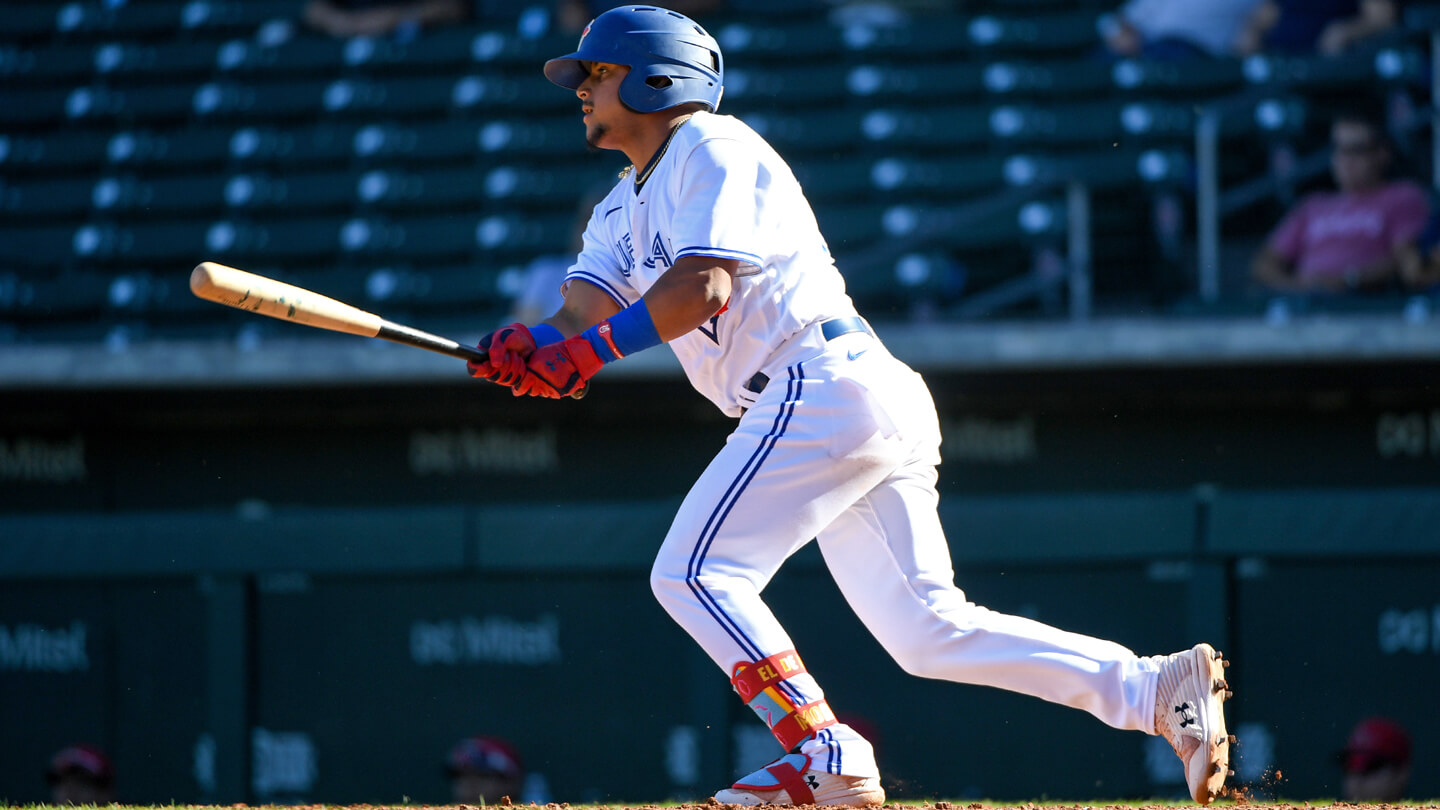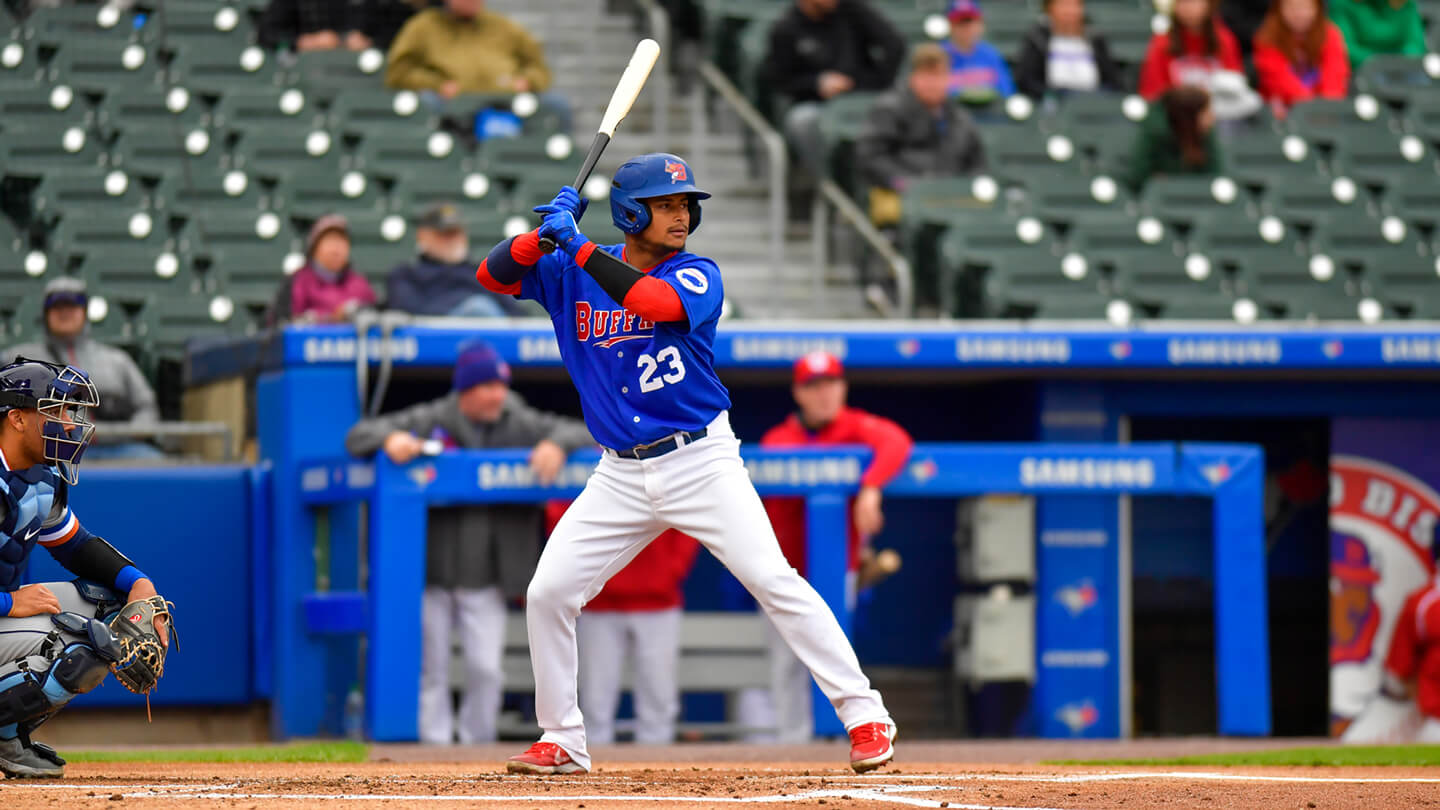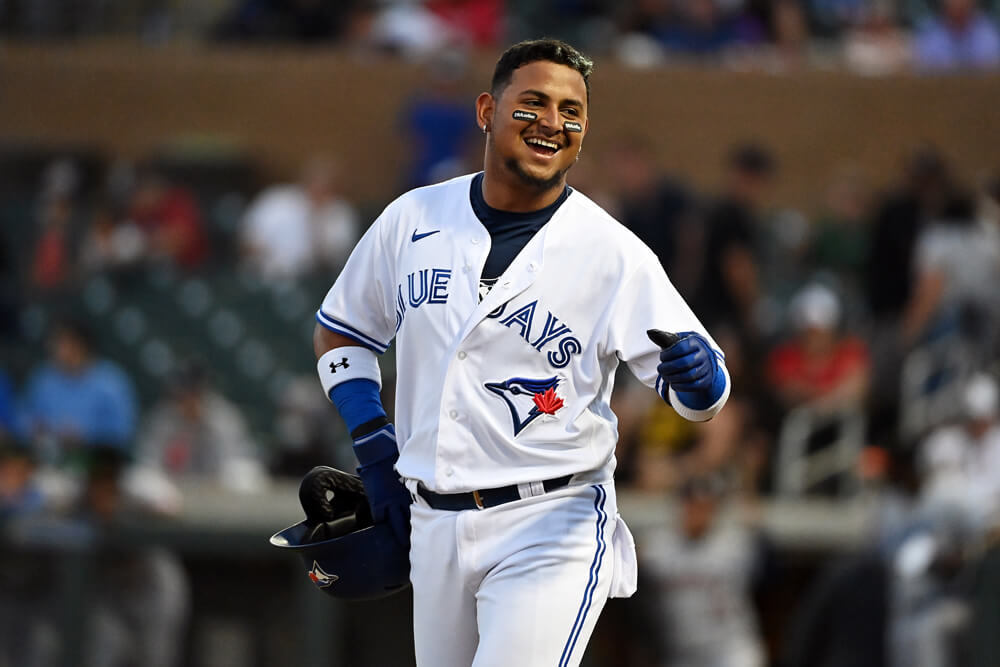
FLUENT IN BASEBALL

G
abriel Moreno closes his eyes and takes a deep breath. He’s gripping a dark brown bat and is standing just to the right of home plate at Field 1 of the Toronto Blue Jays player development complex in Dunedin, Fla. It’s a breezy, sun-soaked morning in late March and the players in this batting practice group have chosen a Pitbull playlist to match the tropical weather and soundtrack their swings.
Moreno’s first two rounds of cuts were nothing special, producing a string of weak bloops to left and centre field. That’s understandable, though, as the 22-year-old Venezuelan only arrived at spring training two days ago after encountering visa issues. He’s still in the process of ramping up baseball activities.
The catcher breathes deeply, readying himself for his third round as “International Love” blares on the nearby speakers. This time Moreno is more like himself. He sprays pitches into the left and centre-field gaps — progression that brings a smile back to his face. In the next round, he clears the fence in left field, evoking some ‘Ooohs’ from teammates.
The odd bit of rust aside, hitting has never been a problem for Moreno. His elite bat speed, hand-eye coordination and contact ability led the Blue Jays to sign him in 2016. That offensive prowess helped him become the jewel of the organization’s minor-league system as well as a top-five prospect in all of baseball, and now it’s taken him to the majors. Danny Jansen’s left pinky fracture has opened a door for Moreno, who is set to join the Blue Jays for this weekend’s series in Detroit. He arrives in The Show more than a one-way player, though. Defence was always going to be the element of his game that needed the most work and credit to Moreno, he’s been acutely aware of this. A converted shortstop, he’s worked hard to become the strong defender that he is today and spent the past few months polishing the finer elements and soft skills of the craft. He knew that his progression behind the plate was essential to his future. “It’s really important because that’s what I need to do to help the team,” he says.
That’s evident on this 19-degree morning in Florida. As soon as Moreno lays down the bat, he rushes off to the clubhouse to grab his catcher’s equipment and minutes later, he’s squatting down, ready to receive a bullpen session from veteran right-hander Jose Berrios. When that’s over, the two huddle, along with pitching coach Pete Walker, for a brief discussion near the mound. Moreno then heads over to the batting cage tent with bullpen catcher Luis Hurtado.
Moreno and Hurtado, a fellow Venezuelan, have a relationship that stretches back to the beginning of the younger catcher’s tenure in the organization. Moreno trusts Hurtado, who in turn takes pride in helping develop the promising prospect. With both men positioned about eight feet apart, a kneeling Hurtado tosses balls that Moreno must frame — receiving with slight movement of the glove designed to increase the chance an umpire sees a strike. After some time, Hurtado walks to the pitching machine and loads it with handfuls of balls from an equipment bag. He lobs encouraging words to the catcher as the ammunition is fired toward him.
“Bueno. Bueno. Nice. Toma.”
“La Jeepeta” by Puerto Rican artist Nio Garcia is providing the soundtrack now, while most Blue Jays teammates have retreated to the clubhouse. When Hurtado’s equipment bag is empty, he jogs over to the bucket that’s next to Moreno and carries it back to the machine. The process begins again, this time with Moreno catching the ball and springing to his feet, right arm cocked back and ready to throw as if a runner is trying to swipe second.
“Bueno. Bueno. Look up. Target down.”
Next up is a blocking drill that sees Hurtado resume his position eight feet from Moreno, tossing balls forcefully into the dirt. There’s a word in Spanish that Hurtado has always used to describe Moreno: “In our country, we would say he is hambriento,” Hurtado says. “He’s hungry to be the best version of himself. He’s hambriento to learn the catching program to become the best catcher he can.”

M
oreno was born on Valentine’s Day in 2000 and grew up in Barquisimeto, a city in northwestern Venezuela. His father, Jose, worked construction and his mother, Marianela, stayed at home to tend to Moreno and his older siblings, Alex, Maria and Antonio. Moreno began playing baseball at a young age, competing with Alex. Before long, he developed into a right-handed hitter with tantalizing skill. In 2016, Francisco Plasencia, a scouting coordinator working for the Blue Jays in South America, spotted Moreno at an academy. The way showcases usually work in Venezuela or Dominican Republic is that agents present a few main players they figure will generate the most interest from MLB clubs. Moreno wasn’t one of those headliners. He stands five-foot-11 and weighs 195 pounds now, but was a lot leaner then, just not as much of a physical specimen as other players. “Gabby wasn’t in that group, but would always push his way into that group,” says Andrew Tinnish, Blue Jays VP of international scouting and baseball operations. “[The showcase organizers would say] ‘Hey, we need an extra guy or two to hit,’ and [Moreno] would be there. He felt like he belonged in that group.”
Despite Moreno’s place on the fringes, Plasencia noticed the 16-year-old shortstop. Positive and high-energy, Moreno was athletic and dynamic on the field; explosive with a quick bat, compact swing and good feel for the barrel. Plasencia decided to discreetly visit Moreno’s academy a few times to keep an eye on him. Sometimes it’s beneficial for scouts to view players outside of showcases, where many other executives may be present. In those situations, sometimes young players can try to put on a show to get more attention, bringing a level of effort and engagement that may not truly reflect their natural selves. Moreno was the same player in both situations, according to the scout. “[Plasencia] was like, ‘Hey, this kid always worked,’” recalls Tinnish. “’He always competed, regardless of the setting, regardless of who was around, regardless of who he felt was watching.’”
The club signed Moreno that summer for $25,000 and, feeling that he possessed great hands and arm strength, along with the frame of a catcher, converted him from the infield. Immediately after he inked the deal, Moreno reached out on Facebook to Hurtado, who’s been with the Blue Jays organization in various roles for the past 17 years. Moreno was familiar with his countryman, who was a coach — and former player — with the Cardenales de Lara, a Venezuelan winter ball team based in Barquisimeto. Moreno peppered Hurtado with all kinds of questions about the Blue Jays — What have you been working on with the catchers? What’s the main thing the club wants to see from them? How do they get better? The two have stayed in close contact ever since.
Moreno was shy off the field, according to those familiar with him, but in Hurtado, found a person he could relate to and converse in Spanish with. “I ask him all kinds of questions,” says Moreno. “Even if it’s stupid questions, I’ll ask him and he’ll tell me the answer.”
While Moreno’s demeanour was shy, his bat certainly wasn’t. He entered the Blue Jays system in 2017 and has hit at every level. Over 226 games across five minor-league seasons, he’s slashed .310/.361/.484. In 35 games with the triple-A Buffalo Bisons this year, he’s produced a .323/.377/.406 line with one home run, eight doubles and 23 RBIs.
Tinnish identifies 2018 as a turning point for Moreno. He put on muscle and had made some changes to his swing over the previous winter, incorporating a bigger gather on his back foot that generated more power. “I remember walking over in spring training and watching him take BP. And the first thing I thought was, ‘Whoa, Gabby looks stronger,’” recalls Tinnish. “To the eye test, he looked physically different. If I had to guess, he looked like a solid maybe 15 pounds stronger.
“The ingredients that were always there, apart from his athleticism and his compete or work ethic, were those elite bat-to-ball skills, which are really hard to acquire,” Tinnish continues. “You don’t just teach that; that’s eyes, that’s the brain, the ability to process things and pick up spin and make swing decisions. It’s a combination of things, but he just had that skill at a very elite level and then incorporated a significant increase in strength and bat speed to go with it.”
Moreno began the 2018 campaign with the rookie-ball Gulf Coast League Blue Jays. His manager there was Hurtado. Of course, the skipper was wowed by Moreno’s stick — he hit .413 in 23 games at the level — but what really stood out was his maturity. Moreno went 4-for-5 with two home runs on Opening Day against the GCL Pirates. It was an exceptionally hot day and he caught all nine innings. Hurtado made the call to sit Moreno the next day in an effort to protect his body. “He wasn’t in the lineup the next day after going 4-for-5 with two homers, and yet, he was the best guy in the clubhouse,” says Hurtado. “He said, ‘I understand. I’m going to be there for the next game. I’m okay with that.’
“Some guys are different because after a good game like that, they always want to be in the lineup,” continues Hurtado. “That showed me how humble he is with the game and with the guys around him.”

M
oreno’s ascent to the big leagues was always going to be accompanied by an interesting situation for the Blue Jays front office. The club is built to win now and so, entrusting a rookie such as Moreno with the large responsibilities of a catcher is something the organization has given much thought: “The demands on a catcher are unique,” says Blue Jays general manager Ross Atkins. “Sure, the demands of a right-fielder and left-fielder are exceptional as well. But we’re not asking our centre-fielder and our second baseman to know the repertoires of 15 to 25 pitchers and how those different repertoires should be deployed against nine to 12 hitters on a nightly basis. And we’re also not asking them to ensure that everything about their body language is discreet and subtle so that it can’t be picked up by a camera or another player. The demands from a communications standpoint are also significant. So, we think about those different aspects of the job and of the responsibilities that come with being a major-league catcher.”
Atkins says the Blue Jays have been trying to systematically expose Moreno to the different aspects of the position in a way that prepares him for life behind the plate at Rogers Centre. Moreno’s truncated spring training obviously created challenges on that front, but according to coaches in the organization, he used the little time he had in camp to sit in on game-planning reviews between starting pitchers and catchers Jansen and Alejandro Kirk. As well, he’s made sure to thoroughly pick the brains of both veteran hitters and pitchers.
Moreno has also zoned in on improving his communication skills. Says Atkins: “He quickly will tell us how he’s working on his English and how he’s making sure that’s a factor because he understands that being able to go out to the mound and tell the pitcher, ‘Hey, I want to switch up our signs here for this reason,’ or ‘I want to change the way we’re approaching this. What do you think and how do you feel about that’ even between innings — ‘and oh, by the way, how’s your family doing?’ — he takes to heart how powerful it is to have that relationship and that bond [with pitchers]and he understands the importance of it.”
Like many players in the organization, Moreno has taken English classes. But he’s also sought out and embraced other opportunities and challenges, like the time Blue Jays staff gave Moreno baseball articles written in English for him to study and then asked him to verbally paraphrase the contents and offer takeaways.
One such article was about the relationship that St. Louis Cardinals catcher Yadier Molina built with his pitching corps, including long-time teammate Adam Wainwright. Ask Moreno about it and his eyes light up. The stories clearly impacted him, offering not only a blueprint to follow, laid by respected backstop Molina, but also an engaging way to build up his grasp of English. “I learned that Molina and Wainwright became really good friends in triple-A and they grew up together and had a really good connection — they’ve been in the big leagues together for [almost]20 years,” says Moreno, who refused the help of an interpreter for our interview. “That’s what I’m trying to do. I talk to pitchers about everything. Everything about life. You have to have really good conversation with all the pitchers — relievers, starters. It’s really important because you need to talk between the innings about what pitches to throw, what’s he’s thinking about.”

Gil Kim, the Blue Jays field coordinator who was previously the team’s director of player development, was one of the staff members who worked with Moreno on the reading exercise. He notes the catcher has been proactive in his quest to master English. When the COVID-19 pandemic spurred lockdowns in early 2020, Moreno and other Venezuelan players were stuck at the Blue Jays complex in Florida. Team officials utilized the ample time to work with those players on language activities. Staff members rotated and when it was Kim’s turn to speak virtually with Moreno, their conversation travelled down an unexpected path. “What started as a language exchange ended up in a really thoughtful conversation about the mental toughness required to be far away from home, to not be able to be with your family, to tackle this journey as a professional baseball player,” Kim recalls. “We began diving deeper into each other’s families. He talked a little bit more about his relationship with his brother and his parents and his girlfriend, who’s now his wife. And we just talked a little more personally about each other’s backgrounds and families.”
Kim learned about Moreno’s sibling baseball rivalry with his brother, Alex, and that he had a dog named Lilo. He also learned that Moreno was a thoughtful, caring son who was devoted to his family. Moreno has been helping his family back in Venezuela financially, ensuring that his father doesn’t have to work gruelling hours on construction sites anymore. “A lot of times in this role, you’re always talking about baseball or always helping players learn English and things like that,” says Kim. “But it was a very fulfilling interaction being able to connect with somebody on a more personal level. And not that you’re not always able to connect with people, but there was just a little more meaning behind it, given what he was going through.”
As Moreno looks to carve a solid place for himself in The Show, those types of conversation are going to become more important for him. He’s got a bright future and if he lives up to his full potential, the talented catcher could be behind the plate in Toronto for years, building relationships just like Molina did in the stories he read. “He understands that to become a big-league catcher, to become a great big-league catcher, he’s got to be able to communicate with pitchers,” says Hurtado. “And he’s taken pride in learning English, which is one of the big, big question marks to get to the big leagues. He’s got the tools — he’s got the defence, he’s got the arm, the speed. He’s got the bat. He’s got power. Now, the question is, how can he handle the communication part with the coaching staff and with the pitching staff?”
There are other questions, too, but Moreno’s biggest and best chance to provide some answers has arrived. There will be a fresh, new jersey waiting for him in the Blue Jays clubhouse. Now, it’s up to the top prospect to keep working — and stay hambriento.
Chris Bernacchi/Diamond Images via Getty Images (2); Courtesy of the Buffalo Bisons; Norm Hall/MLB Photos via Getty Images.




